#Realme p3 pro specs
Explore tagged Tumblr posts
Text
Realme P3 Pro 5G Price | launched with Super AI Camera | know full Specifications & Features | Mobile Phone
Realme P3 Pro 5G Price under $3X9 | ₹2X,X90 launched with Super AI Camera know full Specifications & Features. See here what are the prices of Realme P3 Pro in different stores. Realme P3 Pro Price, Full Reviews/ Specifications GeneralDetailsBrandRealmeModelRealme P3 Pro 5GPrice$3X9 | ₹2X,X90 (Note:- See below to know the exact price)Release dateFebruary 2025 (Expected)Form…
#Mobile#Realme P3 5G#Realme p3 pro 5g#Realme P3 Pro launch date in India#Realme p3 Pro price in India#Realme p3 pro release date#Realme p3 pro review#Realme p3 pro specifications launch date#Realme p3 pro specs#tech news#Today Wold
0 notes
Text
Realme P3 Pro Unboxing ⚡️Snapdragon 7s Gen 3 at ₹21,999 !
Realme P3 Pro Specs 6.78 inches, 120 Hz Refresh Rate Qualcomm Snapdragon 7s Gen 3 6000 mAh with 80W fast charging Rear Cameras 50 MP (Wide) + 32 MP (Ultra Wide) + 2 MP (Macro) Front Camera 50 MP Android v15 with realme UI 6 Water Resistance IP68
0 notes
Link
🚀 The Realme P3 Pro 5G is here! Packed with a Snapdragon 7s Gen 3, 50MP camera, and a 6,000mAh battery, this midrange beast is launching in India on Feb 25! 🔥 💰 Starting at ₹23,999 with special discounts! Don't miss out! #RealmeP3Pro5G #RealmeLaunch #TechNews
0 notes
Text
Vivo T3 Ultra Review: Redefining the T-Series Experience When Vivo launched the T3 series, few anticipated another addition this year. But the brand surprised us with the Vivo T3 Ultra, the first "Ultra" edition in the T-series lineup. The term "Ultra" often signifies top-tier configurations and features, and Vivo seems to deliver on that promise with this latest release. But how does it stack up against the competition, particularly Vivo's own V40, which is priced similarly at ₹34,999 and boasts ZEISS optics? Let’s dive into the details to see if the T3 Ultra is a compelling choice.
Verdict
The Vivo T3 Ultra is a well-rounded performer in its price range, even without ZEISS branding in its camera system. It features a robust processor, fluid display animations, and IP68 water and dust resistance, making it a versatile choice for buyers seeking quality and durability.
Design and Display
The T3 Ultra adopts a design aesthetic closely resembling the Vivo V40 series, featuring a circular camera array on the back and an Aura Light Ring, giving it an elegant, premium look. Available in Lunar Grey and Frost Green, the phone feels comfortable to hold, even with its 5,500mAh battery.
Key Display Specs:
Size: 6.78-inch AMOLED with 1,260 x 2,800 resolution
Refresh Rate: 120Hz
Brightness: 4,500 nits peak
Color Accuracy: 100% DCI-P3, 105% NTSC
The curved AMOLED display offers vibrant colors, deep blacks, and excellent brightness, making it ideal for outdoor use. However, users who prefer flat screens might find the curved edges slightly reduce viewing angles.
Cameras
The camera setup is headlined by a 50MP Sony IMX921 sensor with OIS, accompanied by an 8MP ultra-wide lens. While the hardware delivers sharp and detailed photos, especially in portrait mode, the flicker sensor doesn’t perform as expected during video recording in low light.
Camera Highlights:
Rear Camera: 50MP + 8MP
Front Camera: 50MP ultra-wide with AI Facial Contouring
Video Recording: 1080p FHD
Overall, the T3 Ultra is good for casual photography but occasionally smoothens skin tones excessively during processing.
Performance and Software
The Vivo T3 Ultra is powered by the MediaTek Dimensity 9200+ chipset, built on a 4nm process. With a 3.35 GHz Cortex-X3 core and 11-core Immortalis-G715 GPU, it handles multitasking and gaming effortlessly. The phone includes 8GB RAM (expandable to 24GB with virtual RAM) and 128GB storage.
Performance Metrics:
AnTuTu Score: 1,445,926
Geekbench: Outperformed rivals in CPU-intensive tasks
The phone runs Android 14 with FunTouchOS 14. While the UI is smooth and uncluttered, Vivo’s AI features remain limited compared to competitors like OPPO.
Battery Life and Charging
The 5,500mAh battery supports 80W Flash Charge, taking the phone from 20% to 100% in just 38 minutes. However, the phone tends to warm up during fast charging, and battery life under heavy gaming drains faster than expected, losing about 23% after an hour of gameplay.
Battery Test Results:
PCMark Battery Test: 12:14 hours
Charging Time (20%-100%): ~38 minutes
Final Verdict
The Vivo T3 Ultra combines high performance, elegant design, and robust features like IP68 resistance, making it a strong contender in its segment. While it may not match the V40 Pro's camera prowess, it holds its ground against competitors like the Realme GT 6T.
Editor’s Rating: 8.5/10
Pros:
Powerful Dimensity 9200+ processor
IP68 water and dust resistance
Excellent portrait photography
Cons:
Flicker sensor performance is inconsistent
Image processing can over-smoothen details
gadgetzview.com
#Vivo T3 Ultra#Vivo T3 Ultra review#Vivo smartphones#Vivo T-Series#5G smartphones#MediaTek Dimensity 9200+#Android 14#AMOLED display#120Hz refresh rate#50MP camera
0 notes
Text
Sony A80K OLED TV Review, Design, Price and Release Date
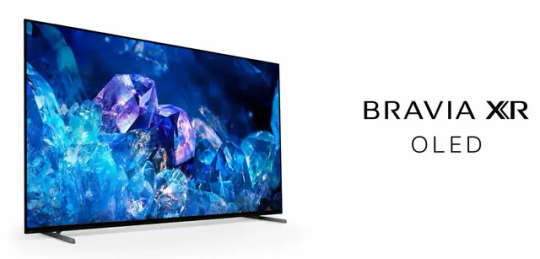
Sony A80K OLED TV Overview: The Sony A80K combines the remarkable contrast and rich color palette expected from OLEDs. In addition, it's enhanced with 4K 120Hz capabilities ideal for gaming and the unique Acoustic Surface Audio+ technology from Sony. This OLED TV delivers stellar performance without stretching your budget. Prices: €1,309 at OTTO DE (55-inch) €1,429 at Coolblue DE €1,999 at EURONICS DE (65-inch) Pros: Superior contrast with deep blacks and noteworthy brightness True-to-life colors straight out of the box in Cinema mode Comprehensive HDMI 2.1 features tailored for gamingCons: Slightly less brightness compared to leading OLED TVs Basic remote design missing backlight feature Absence of HDR10+ compatibility.
Sony A80K Review
The Sony Bravia XR A80K OLED is passionately engineered to redefine the boundaries of home entertainment. Remarkably, it excels in this pursuit, making it all the more surprising that its price tag isn't steeper. While the A80K isn't easy on the wallet, its value is undeniable. As one of Sony's premium OLED offerings, it's brimming with the brand's top-tier visual and auditory tech. Even though it might not outshine every competitor in all aspects, it undeniably ranks as one of the top TV purchases available. SONY BRAVIA XR A80K - SPECS - Price: $1,499.99 - Screen Size: 55-inch - Model Number: XR-55A80K - Resolution: 3,840 x 2,160 pixels - HDR Compatibility: HDR10, Dolby Vision, HLG - Refresh Rate: 120Hz - Connectivity: - HDMI: 2 ports of HDMI 2.1, 2 ports of HDMI 2.0 - USB: 2 ports - Audio Output: 50W - Smart TV Platform: Google TV - Dimensions (without stand): 48.38 inches (width) x 28.13 inches (height) x 2.13 inches (depth) - Weight (without stand): 39.5 lbs. This TV merges the best of Sony's technology, delivering exceptional picture quality, sound, and smart features.
Sony A80K Design Review
The A80K flaunts Sony's elegant One Slate design, seamlessly merging aesthetics with an all-glass front panel, roughly half an inch deep. This cohesive look is undeniably eye-catching. Incorporating functionality, an inset at the back facilitates hassle-free connections, complemented by a snap-on cover to manage and hide cables. The TV comes with a versatile three-way stand that can be adjusted for various setups – whether you want it flush with the stand or elevated to accommodate a soundbar. In my setup, I utilized the latter, gaining a good three inches of clearance. If you possess one of those bulkier soundbars, this stand offers the flexibility you need. For those who prefer wall installations, Sony offers an optional bracket. https://www.youtube.com/watch?v=q-Y-HDuAAxs Sony's accompanying remote is succinct in its design – a departure from the larger, glow-in-the-dark versions from their past models. While its straightforward button configuration is user-friendly, the absence of a backlit keypad can be a slight inconvenience in low light settings. However, Sony earns kudos for the remote's textured surface, minimizing the risk of it slipping through fingers or vanishing in the couch gap. Design Rating: 4.5/5.
Sony A80K Features Overview
Equipped with Google TV, the A80K OLED allows smooth app navigation, complemented by the convenience of Google Assistant for voice-activated searches. This is made possible through the microphone incorporated into the Sony remote. Popular streaming services such as Netflix, Disney+, Amazon Prime Video, HBO Max, and Apple TV are easily accessible, with dedicated buttons on the remote for quick access. In the realm of picture quality, the 2022 Sony OLED models are enhanced with the XR OLED Contrast Pro and Cognitive Processor XR technologies. These work in tandem to optimize brightness and deepen blacks dynamically, adapting to each scene. Furthermore, the broad color gamut panel, coupled with the XR Triluminos Pro and Cognitive Processor XR, ensures faithful color reproduction, covering the full DCI-P3 spectrum – the gold standard for digital cinema and Ultra HD Blu-ray content. Connectivity-wise, the A80K boasts four HDMI ports, of which two are HDMI 2.1 compliant. This means they support advanced features such as 4K at 120Hz, VRR, and ALLM. For US viewers, there's an added bonus: the A80K incorporates an ATSC 3.0 tuner. This advanced tuner facilitates access to free over-the-air digital TV broadcasts in the latest format, promising 4K visuals accompanied by Dolby Atmos audio. While ATSC 3.0 had a modest beginning, its adoption is on the rise, with predictions of it reaching three-quarters of the US market by the end of 2022. Feature Rating: 4.5/5.
Sony A80K Sound Quality Overview
The A80K OLED TVs are equipped with Sony's innovative Acoustic Surface Audio+ technology. By utilizing five actuators — three behind the screen and two on the sides — the screen itself is vibrated to produce encompassing sound, with two additional subwoofers augmenting bass levels. Additionally, features like Acoustic Audio Calibration adapt sound to the room's acoustics, Voice Zoom sharpens dialogue, and 3D surround upscaling enriches the auditory experience. While I often bypass a TV's native sound system in favor of external setups, I found the A80K's sound performance commendable. Dialogues were articulate and clear, even at higher volumes without any discernable distortion. The Dolby Atmos mode provided an immersive soundscape, with perceivable vertical and overhead sound dimensions. While an external Dolby Atmos soundbar might have fine-tuned the audio experience further, the A80K’s inherent sound system is impressive enough, especially for those not regularly indulging in action-packed cinema or those who prefer not to invest in an additional soundbar. Sound Quality Rating: 5/5.
Sony A80K Pricing and Availability Overview
Release Date: May 30, 2022 Pricing: - XR-55A80K: $2,000 (US) / £2,099 (UK) / AU$3,899 (Australia) - XR-65A80K: $2,300 (US) / £2,899 (UK) / AU$4,999 (Australia) - XR-77A80K: $3,300 (US) / £3,999 (UK) / AU$7,999 (Australia) Sony unveiled the A80K in the latter part of spring 2022. Positioned as the brand's mid-tier OLED model, the A80K's price point is notably more accessible compared to Sony's premium A95K QD-OLED lineup. In terms of competition, LG's C2 OLED stands out. The pricing dynamics between the Sony A80K and LG C2 vary by region. For instance, in the US, the 65-inch and 77-inch A80K models are priced slightly below their LG C2 counterparts, while the 55-inch variant leans towards a higher price compared to the LG C2 of the same size. Meanwhile, in the UK, Sony's A80K has a steeper price across all sizes when juxtaposed against the LG C2.
Sony A80K Picture Quality Overview
With its impressive 99.5% coverage of the DCI-P3 color space for 4K HDR, the A80K showcases a vibrant display. Its brightness capabilities are noteworthy for an OLED TV, boasting 785 nits in Vivid mode and a commendable 616 nits in Cinema mode. Though it doesn't match the brilliance of the Samsung QN95B mini-LED QLED or LG's flagship G2 OLED, its brightness suffices for most ambient settings. During my real-world testing with the Netflix documentary, "My Octopus Teacher," the display remained vivid, even with overhead lights. Despite lacking anti-glare features like Samsung's The Frame, reflections were minimal. The OLED panel ensures consistent visuals from varied angles. While the A80K misses the Filmmaker picture mode found in many premium TVs, its Cinema mode proves color accurate right out of the box. However, purists may need to adjust the default Motionflow settings. Key Specifications: - Screen Size: 55, 65, 75 inches - Resolution: 4K - Panel Type: OLED - HDR Support: Dolby Vision, HDR10, HLG - Audio: Dolby Atmos, Dolby Digital, DTS - Smart TV Platform: Google TV - HDMI Ports: 4 The A80K's 120Hz refresh rate delivers proficient motion handling, though some artifacts were observed, which could be mitigated through Motionflow settings. Its prowess in upscaling HD content to 4K was evident, possibly due to enhancements in Sony’s Cognitive Processor XR for 2022. In a dimly lit setting, 4K Blu-ray titles like "Dune" and "The Batman" were spectacular, exhibiting true blacks and intricate details in dark scenes. Bright HDR elements, juxtaposed against these dark backgrounds, offered a striking, almost 3D appearance. The capability to measure 0 nits on a full-black window pattern underpins its exceptional black rendition and robust contrast, especially under dim lighting. Picture Quality Rating: 4.5/5.
Sony Bravia XR A80K TV Ports Overview
The power cable for the A80K connects on the right side of its rear panel. Conveniently, all other ports are situated on the left, directly facing sideways for easy access. The lineup includes: - Two USB ports (one at 500mA and the other at 900mA). - S/PDIF optical audio output. - Composite video and S-Center speaker port. - Ethernet port. - RS-232C and IR input jacks. - Coaxial cable input. - Four HDMI ports. Of these HDMI ports, two are based on the latest HDMI 2.1 specification, boasting a hefty bandwidth of 48Gbps and modern features such as VRR and ALLM. One of these HDMI 2.1 ports is also eARC compatible. However, the other two HDMI ports stick to the older HDMI 2.0 standard. Although many TVs still feature exclusively HDMI 2.0 ports, it's a tad underwhelming to see this on the A80K. Nonetheless, this might not be a major concern for the average user.
Sony Bravia XR A80K TV Review: Technical Insights
While the real-world viewing experience is crucial, we ensure a holistic review by conducting a comprehensive suite of technical tests. Our evaluation setup involves using an X-Rite i1 Pro spectrophotometer, a SpectraCal VideoForge Pro pattern generator, and the Calman calibration software by Portrait Displays. For a deeper dive into our testing methodology, refer to our TV testing guide. In these technical evaluations, the A80K held its own, even against robust competitors like the Samsung S95B and the almost iconic LG C2. Test MetricsSony A80KLG C2Samsung S95BSDR Brightness (10%, in nits)232228329Delta-E (lower is better)3.16691.70093.0184Rec. 709 Gamut Coverage108.82.980%HDR Brightness (10%, in nits)6307941050UHDA-P3 Gamut Coverage99.33.16.76%Rec. 2020 Gamut Coverage74.58.84.97% For SDR content, the A80K's brightness of 232 nits was comparable to the LG C2's 228 nits, though it trailed behind Samsung's robust 329 nits. LG C2 took the crown in terms of color precision, showcasing the best Delta-E value. The A80K exhibited a minor color oversaturation, while the others were nearly perfect. When it comes to HDR, the narrative remains consistent. In their calibrated modes, Samsung dominated, but Sony's brightness lagged somewhat. Nevertheless, Sony's gamut coverage for both UHDA-P3 and Rec. 2020 surpassed LG C2 and was only marginally behind Samsung. Given that the A80K, especially the 55-inch variant, is priced a tad lower, its performance metrics are commendable. Moreover, certain inconsistencies in the S95B's display meant that, to the naked eye, the A80K presented a superior visual experience. Weighing in the cost against the features, the A80K emerges as a polished contender, offering an impressive viewing experience both objectively and subjectively.
Sony Bravia XR A80K TV Gaming Review:
When it comes to the recent lineup of Sony TVs, input lag is a bit of a chink in the armor. Using the Leo Bodnar 4K Lag Tester on the A80K, we recorded an input lag of 16.2ms. While this isn't a deal-breaker (with scores under 20ms being acceptable), it doesn't quite match the sub-10ms performance of competitors like LG and Samsung, which we earmark as the gold standard for gaming. Sony Bravia XR A80K TV showcasing Assassin’s Creed Valhalla That being said, the A80K isn't lacking in gaming-centric features. A significant highlight is its HDMI 2.1 ports, enabling 4K gaming at a fluid 120Hz. This ensures a silky-smooth experience, even in high-intensity gaming sequences. This was particularly evident in Assassin’s Creed Valhalla — the game’s snowy landscapes shimmered with realistic brilliance, and the essential coastal raids in the gameplay were as smooth and exhilarating as one would expect. Furthermore, when paired with the PS5, the A80K steps up its game. Features like Auto HDR Tone Mapping tailor the PS5’s settings to maximize the TV's potential. The Auto Genre Picture Mode, reminiscent of ALLM, ensures optimal picture settings, enhancing the visual experience regardless of the content being played.
Sony A80K Value Assessment
Positioned between Sony's high-end A95K QD-OLED and A90K and the more accessible European A75K in their 2022 OLED lineup, the A80K is crafted for those balancing between premium performance and cost-effectiveness. For U.S. consumers, the 65-inch A80K, priced lower than its LG C2 counterpart while offering comparable visual prowess, stands as an attractive proposition. In the UK, while it may lean on the pricier side, the A80K compensates with superior audio capabilities than the LG C2. An alternative avenue for better value might be TVs with QLED technology. However, venturing into the economical side of QLED often demands compromises in performance. Summing up, the 65-inch A80K is a prime choice for those set on acquiring a 4K OLED TV. For those chasing maximum screen size within a budget, without sacrificing quality, QLED emerges as a more fitting option. Should I buy the Sony A80K? Whether or not you should buy the Sony A80K largely depends on your specific needs, preferences, and budget. Here are some factors to consider: Pros of the Sony A80K: - Outstanding Picture Quality: The A80K boasts excellent color accuracy, deep blacks, and detailed shadows, characteristic of OLED panels. - Sound: The Acoustic Surface Audio+ technology delivers immersive sound quality without needing external speakers. - Gaming: While it might not be the absolute best in terms of input lag, the inclusion of HDMI 2.1 ports allows for high-refresh-rate gaming, making it compatible with next-gen consoles. - Design: The slim and sleek design, coupled with the One Slate concept, makes it an aesthetically pleasing addition to any room. - Smart Features: Powered by Google TV, it offers a wide array of apps and streaming services. Cons of the Sony A80K: - Input Lag: Some competitors, especially those designed with gaming in mind, offer lower input lag. - HDMI 2.1 Ports: It has fewer HDMI 2.1 ports compared to some other modern TVs, which might be a consideration for those with multiple high-end gaming consoles or other devices. - Price: OLED TVs generally cost more than their LED or QLED counterparts, and while the A80K offers value for its price, there are cheaper options available, especially if you are willing to compromise on some features. Things to consider: - Viewing Environment: OLEDs are known for deep blacks and great contrast ratios, making them ideal for dimly lit or controlled lighting environments. If your room is very bright, you might want to consider other options or ensure you can control the lighting. - Burn-in Concerns: Like all OLED TVs, there's a risk (albeit minimal with proper use) of burn-in over time. This happens when static images are displayed for prolonged periods repeatedly. Verdict: If you're in the market for a high-quality OLED TV with excellent picture and sound, and you value Sony's design and user interface, the A80K is a strong choice. However, if gaming performance is your top priority or you're budget-conscious, you might want to compare it with other options like the LG C2 or certain QLED models. Always consider what features are most crucial for you and how they align with your budget. Conclusion While the Sony Bravia XR A80K is an impressive piece of tech, it isn't without its shortcomings. TVs like the Samsung S95B may offer slightly enhanced brightness and color vibrancy. Furthermore, both the Samsung S95B and the LG C2 boast additional HDMI 2.1 ports and superior gaming features, which could be pivotal for gaming enthusiasts. The A80K isn't even Sony's crown jewel – that honor goes to the pricier Sony A95K OLED. Also, it bears striking resemblance in features and performance to its predecessor, the Sony Bravia XR A80J. Yet, when contemplating a new TV purchase, the Sony Bravia XR A80K emerges as a comprehensive package that promises a delightful viewing experience each time it's powered on. Read the full article
0 notes
Text
Motorola Moto G82 5G launch date revealed for the Indian market

Motorola has just confirmed the launch date of the Moto G82 5G for the Indian market. The device will debut this month with impressive specs over the competition. It will come with a 10-bit pOLED panel and have 50MP cameras. Upon launch, the phone will rival the OnePlus Nord CE 2 Lite 5G, Redmi Note 11 Pro+ 5G, and Realme 9 Pro 5G. Also Read - Motorola Moto E32s goes official with a 90Hz display
Motorola G82 5G Launch date in India
Motorola has officially confirmed that its next phone in the G-series, the Motorola Moto G82 5G will debut on June 7 in India. It is expected to arrive in White Lily and Meteorite Gray color variants. The phone will be available to purchase from online stores like Flipkart, Reliance Digital, and Motorola’s official website. Also Read - Motorola Maven a.k.a Razr 3 shows up in a hands-on video
Motorola G82 5G Specifications
Coming to the specifications, the Motorola Moto G82 5G will come with a 6.6-inch pOLED panel with a Full-HD+ resolution and 120Hz refresh rate. The screen will have a DCI-P3 color gamut, 360Hz touch sampling rate, and DC dimming support. Interestingly, the phone will feature a 10-bit panel, which is usually seen in premium phones. Also Read - Motorola schedules a launch for July for its 200MP camera phone, likely the Motorola Frontier.
As for power, the smartphone will be powered by the Qualcomm Snapdragon 695 5G processor with Adreno 619L GPU. It will be paired with 6GB of RAM and 128GB of internal storage. It will also have a microSD card slot for additional storage of up to 1TB.
It will come with a triple camera system at the rear with a 50MP main lens, an 8MP ultra-wide lens, and a 2MP macro unit. The main sensor will have an f/1.8 aperture and feature Optical Image Stabilization (OIS) support. Upfront, it will have a 16MP selfie camera with an f/2.2 aperture.
The phone will come with a 5,000mAh battery with support for 30W Turbo fast charging support. It will boot on Android 12 OS out of the box and have My UX skin on top of it. The device will also have IP52 water and dust resistant rating.
Expected Pricing
Motorola is yet to reveal the phone’s pricing, but if an educated guess is to be done, we expect the phone to cost around Rs. 20,000. With that price, the phone is expected to take on the likes of the OnePlus Nord CE 2 Lite 5G, and Redmi Note 11 Pro+ 5G, Realme 9 Pro 5G.
Source
0 notes
Text
Realme X7 Pro, Realme X7 with MediaTek 5G processors launched: Price, Specs

Realme on Thursday launched in India the Realme X7 Pro and Realme X7 smartphones with 5G network support. Powered by MediaTek processors, the smartphones comes with up to 8GB RAM and 128GB on-board storage. The Realme X7 Pro comes with 8GB RAM and 128GB on-board storage, priced at Rs 29,999. It will be available on Flipkart, Realme online store and select offline stores from February 10. The Realme X7 is priced at Rs 19,999 and Rs 21,999 for 6GB/128GB and 8GB/128GB variants, respectively. It will be available from February 12, online on Flipkart and Realme online store, and select offline stores. The Realme X7 Pro comes in fantasy and mystic black colours, whereas, the Realme X7 comes in space silver and nebula colour options.
Realme X7 Pro: Specifications
The top-end model in the Realme X7 series, the Realme X7 Pro sports a 6.55-inch super AMOLED fullHD+ resolution screen of 120Hz refresh rate and 240Hz touch sampling rate. The screen is touted to have 1200 nits peak brightness level, 100 per cent DCI-P3 and 103 per cent NTSC colour gamut. Protecting the screen is a Corning Gorilla Glass 5. The smartphone weighs 184g and boasts 8.5mm thick profile.
Powering the Realme X7 Pro is a 5G network ready MediaTek Dimensity 1000+ system-on-chip, paired with up to 8GB LPDDR4x (four-channel) RAM and 128GB UFS 2.1 (Turbo write) on-board storage. The phone ships with Android 10 operating system based Realme UI. It will receive Android 11 OS based Realme UI 2.0 in near future.
Imaging is covered by a quad-camera array on the back, featuring a 64-megapixel primary sensor (Sony IMX 686) of an f/1.8 aperture, an 8MP ultra-wide-angle sensor of an f/2.25 aperture and 119-degree field of view, a 2MP monochrome sensor and a 2MP macro sensor.
Read Complete Article
0 notes
Text
Oppo phones Review

The Chinese Oppo Electronics Corporation was registered in 2004. Today, the company produces premium consumer electronics, as a division of BBK Electronics. Founded in 1995, BBK Electronics LTD is one of the largest manufacturers of consumer electronics in China. Moreover, BBK Electronics also owns Vivo Communication Technology Co. Ltd, Realme and OnePlus. Today, the share of Oppo and Vivo companies reaches 9% and 8% of the global market. Thus, their total share reaches 17%. For comparison, the share of the leading Samsug is also 17%. According to the results of the third quarter of 2019, Oppo and Vivo were included in the list of the most profitable companies along with Samsung, Apple, Huawei and Xiaomi. Formally, they compete with each other. But in fact, companies are focused on different markets. In particular, Oppo is active in America, Europe and India, and Vivo mainly works in the Chinese market.
Introduction
As a technology company, Oppo actively uses innovative solutions. Find X recently beautifully illustrated this trend. As known, in 2017, Apple engineers were among the first to implement cutout in the iPhone X, trying to create a frameless smartphone. This solution successfully eliminated the problem of front-facing camera placement in a frameless design, freeing up space for additional pixels. Unfortunately, many experts criticized its aesthetics despite the real increase in the screen surface. As a result, in 2018, Oppo optimized this solution by proposing Find X with a retractable camera in the upper part of the case.

When starting the camera app, the hidden module automatically rises within 0.5 seconds. Moreover, it also contains a rear-facing camera. Perhaps in the future, this solution will be able to compete successfully with cutout design. Today, Oppo produce phones in their A series, RENO series, Find series, F Series, N series and R series. However, the company does not very strictly follow its own classification. For example, according to many experts, F15 is a global version of the Oppo A91 introduced in December in China.
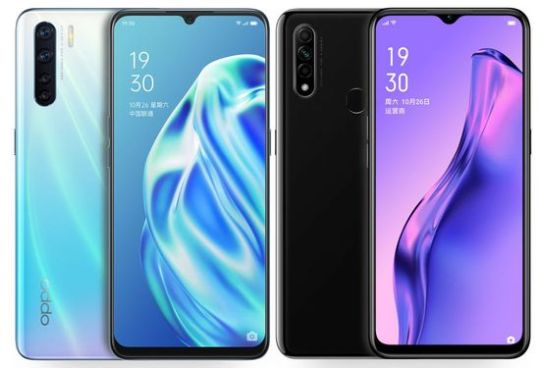
Oppo A5s
Series A includes mid-budget smartphones. In April 2019, Oppo launched the A5s.

The model uses a 6.2-inch InCell IPS display (92% sRGB and 68% AdobeRGB) with 720 x1 520 resolution (271 ppi density), 8-core Helio P35 (4 x Cortex-A53, 2.3 GHz + 4 x Cortex-A53 , 1.8 GHz) chipset with PowerVR GE8320, RAM 2/3/4 GB and 32/64GB Storage. As known, in 2018 Xiaomi first installed Helio P35 on Mi Play. In fact, it replaced the not-so-popular Helio P30. According to the company, today it produces P35, P60, P70 and P90 using the 12nm FinFET (fin field-effect transistor) process technology from TSMC, which provides a significant reduction in energy consumption. In addition, the company offers CorePilot technology to optimize energy consumption. Additionally, the P35 supports AI functionality. In addition, the smartphone has an 8MP front-facing camera with f/2.0, and double camera system (13MP + 2MP with f/2.2 and f/2.4).
Oppo A8 and Oppo A91
In December, in China, the company introduced two more models of this series, including the A91 and A8.

The Oppo A8 uses a 6.5-inch IPS display with 1600 x 720 resolution (270 ppi density), an octa-core MediaTek Helio P35, triple camera system (12 MP, f/1.8, wide, PDAF + 2 MP, f/2.4, 1/5",1.75µm, macro camera + 2 MP, f/2.4, 1/5", 1.75µm, depth sensor) and 8 MP, f/2.0 selfie camera, 4GB RAM, 128 GB storage, a fingerprint scanner and a 4230 mAh battery. In addition, it supports 2 SIM cards. The Oppo A91 has a 6.4-inch AMOLED screen with 2400 x 1080 resolution (408 ppi density), 12nm 8-core Mediatek Helio P70 (ARM big.LITTLE architecture - 4 x Cortex A73, 2.1 GHz + 4 x Cortex A53 , 2.0 GHz) chipset with Mali-G72 MP4 GPU, four camera system (48 MP, f/1.8, 26mm, (wide) 1/2.0", 0.8µm, PDAF + 8 MP, f/2.2, 13mm (ultrawide), 1/4.0 ", 1.12µm + 2 MP, f/2.4, 1/5", 1.75µm (dedicated macro camera) + 2 MP, f/2.4, 1/5", 1.75µm, depth sensor) and 16 MP, f/2.0, 26mm (wide), 1/3.1", 1.0µm selfie camera, 8GB RAM, 128 GB storage, fingerprint (under display, optical), accelerometer, gyro, proximity, compass and Li-Po 4025 mAh battery. The cost of A5s and A8 varies in the range of $ 150-170. The price of A91 reaches almost $ 300 in China.
F Series
The models in this series use the innovative AI SelfieTune integrated face recognition technology. The company first used it in an Oppo F5. Oppo F7 (Selfie Expert) uses the second generation of AI SelfieTune 2.0. In particular, it recognizes and optimizes 296 reference points on the face, which exceeds the first version by 20%. In 2019, the company introduced the Oppo F11 and Oppo F11 Pro.
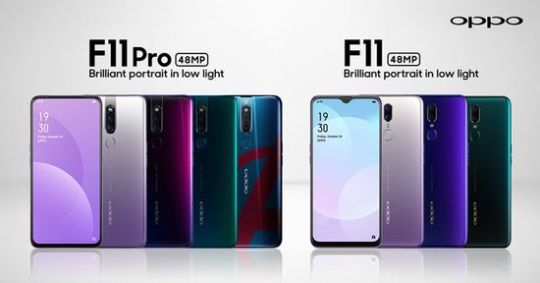
Both models work under Android 9.0 Pie. They use a 6.5-inch LTPS IPS LCD display with 2340 x 1080 resolution (397 ppi), an 8-core Mediatek Helio P70 and dual camera system (48MP + 5MP). But the F11 Pro uses a motorized pop-up 16MP front camera that automatically rises above the panel.
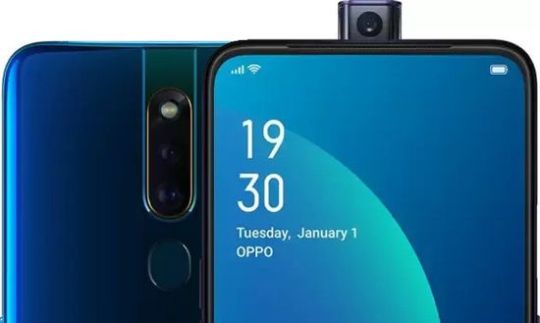
The F11 selfie camera does not have this feature.
Oppo K Series
In 2018 the company introduced the first Oppo K1 smartphone, and in 2019 - Oppo K3 and Oppo K5. Both models support DC Dimming technology, which reduces the flickering the AMOLED displays due to low PWM. As known, DC Dimming eliminates flicker, reducing eye strain, but can distort color reproduction. In fact, Oppo K3 is an improved version of last year's K1.
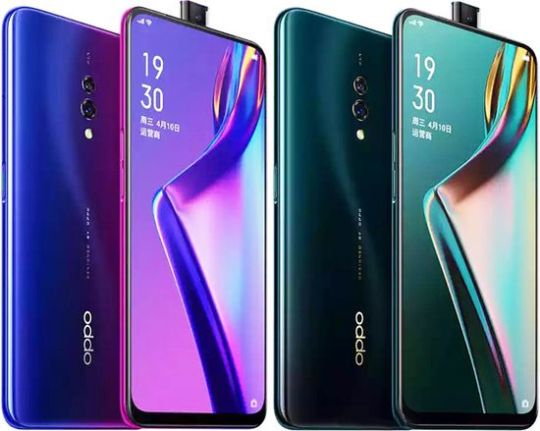
The model uses a 6.5-inch AMOLED display with 1080 x 2340 resolution (394 ppi density), 10nm Qualcomm Snapdragon 710 octa-core (2 x Kryo 360 Gold (Cortex-A75), 2.2 GHz + 6 x Kryo 360 Silver (Cortex-A55) , 1.7 GHz) with Adreno 616, 6GB RAM, 64GB storage, 16MP f/1.7 + 2MP f/2.4 (dual main camera) and built-in 16MP retractable selfie camera with f/2.0, 3765 mAh battery, has a fingerprint scanner, supports 2 SIM cards, SlowMotion and VOOC 3.0 flash charge. High performance, efficient throttling (algorithm to protect the processor from overheating by skipping work cycles), high battery life, DC Dimming and wide color coverage are pros of this model. Unfortunately, the model does not have an NFC module (Near field communication) and a microSD slot. Model costs $ 350-400. The Oppo K5 targets the Indian market and costs about $ 100 less.
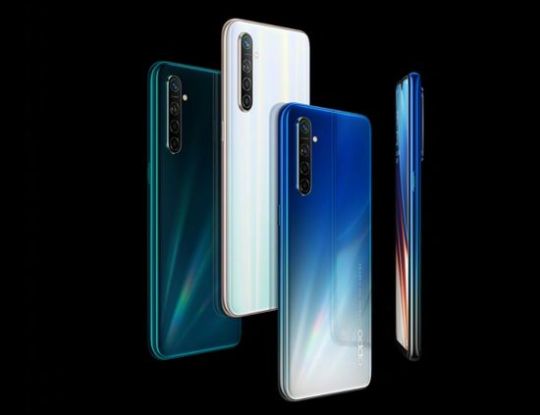
The model uses a 6.4-inch AMOLED display with 1080 x 2340 resolution (402 ppi density), the newer 7nm 8-core Qualcomm Snapdragon 730G (2 x Kryo 470 Gold (Cortex-A76), 2.2 GHz + 6 x Kryo 470 Silver (Cortex- A55), 1.8 GHz) with Adreno 618, 6GB RAM, 128GB storage, four camera system (64MP + 8MP + 2MP + 2MP) with autofocus and OIS, 32MP selfie camera, Li-Po 4000 mAh battery. Of course, it has a set of traditional sensors.
Oppo Reno
The company is positioning Oppo Reno as a sub-brand, with high hopes for it. Oppo Reno and Reno 10x Zoom were the first models of the new series.
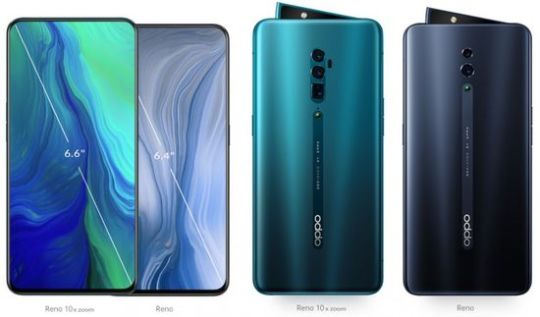
In terms of price and specs, the Reno 10x Zoom competes with the Huawei P30 Pro. Smartphones work under Android 9 Pie with ColorOS 6 interface. Like K3, Oppo Reno uses a 10nm 8-core Qualcomm Snapdragon 710 (2 x Kryo 360 Gold (Cortex-A75), 2.2 GHz + 6 x Kryo 360 Silver (Cortex-A55), 1.7 GHz) with Adreno 616. But Reno 10x Zoom has a more powerful 7nm 8-core Qualcomm Snapdragon 550 (1x Kryo 485, 2.84 GHz + 3 x Kryo 485, 2.42 GHz + 4 x Kryo 485, 1.78 GHz). Oppo Reno uses a dual camera system (Sony IMX586 48MP sensor with f/1.7 and OIS, and an 8MP sensor with f/2.2) and a built-in 16MP retractable selfie camera without flash. This design many often call shark fin. But Reno 10 x Zoom has an additional periscope telephoto lens with a 10x hybrid zoom. Moreover, its resolution reaches 13 MP vs 8 MP in the Huawei P30 Pro. Oppo Reno uses a 6.4-inch FullHD+ AMOLED display with 2340 x 1080 resolution (402 ppi), with Corning Gorilla Glass 6 and support for DCI-P3 standard. In general, the list of its pros includes a design with shark fin, a good display, fast VOOC 3.0 charging and a fairly high shooting quality. The Reno 10x Zoom has a 6.6-inch display (387 ppi density) with similar specifications. Today, its price varies in the range of $ 600-700 (6GB RAM, 128GB storage / 8GB RAM, 256GB storage). Of course, 6.6-inch display and an excellent telephoto lens with a 10x hybrid zoom are its main pros.
Oppo Reno2, Reno2 F и Reno2 Z
Of course, they all have pop-up selfie cameras to provide edge-to-edge displays.
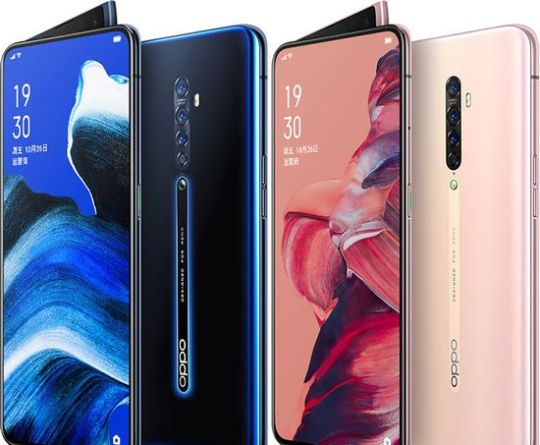
All models use almost identical frameless AMOLED capacitive touchscreens which is protected by Gorilla Glass 6 technology. Reno 2 and Reno 2 F have 6.5-inch screens with 1080 x 2400 (401 ppi) and 1080 x 2340 (394 ppi) resolutions, respectively, and Reno 2 Z have a 6.53-inch screen with 1080 x 2340 resolution (395 ppi). All phones use the traditional four camera system.
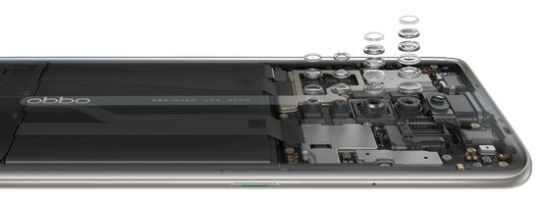
But their systems differ slightly in modules. For example, Reno2 received a 13MP telephoto lens.

The Reno2 F and Reno2 Z cameras are almost identical.
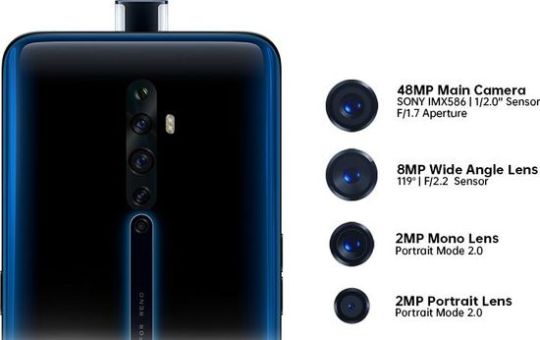
But models have different chipsets. In particular, Reno2 uses an 8nm Qualcomm Snapdragon 730G (2 x Kryo 470 Gold, 2.2 GHz + 6 x Kryo 470 Silver, 1.8 GHz) with an Adreno 618 GPU, Oppo Reno2 F - 12nm Mediatek Helio P70 (4 x Cortex-A73, 2.1 GHz + 4 x Cortex-A53, 2.0 GHz) with Mali-G72 MP3, Reno2 Z - 12nm Mediatek Helio P90 (2 x Cortex-A75, 2.2 GHz + 6 x Cortex-A55, 2.0 GHz) with PowerVR GM9446. Of course, Qualcomm Snapdragon 730G performance is higher compared to Mediatek, but Helio P70 and P90 are also very powerful chipsets. All models have 8 GB of RAM, VOOC Flash Charge 3.0 function and 4000 mAh Li-Po battery. PROS - good 6.5-inch screen with Gorilla Glass 6; - 8GB RAM; - 13MP telefoto lens and Qualcomm Snapdragon 730G in Reno2; - shark fin; - Dolby Atmos sound. Cons - no NFC module in Reno2 F and Reno2 Z; - no wireless charging.
Oppo Reno Ace
In October 2019, Oppo released inexpensive flagship Reno Ace.
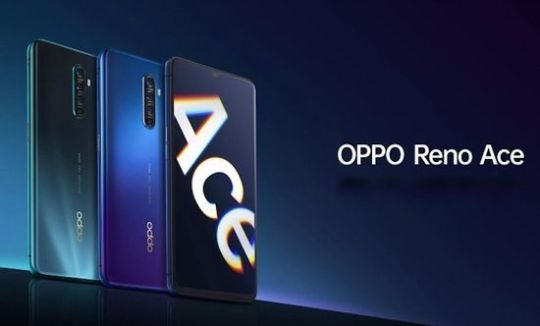
The novelty supports SuperVOOC Fast Charge 2.0 technology of high-speed charging power of 65 watts, which provides charging 4000 mAh battery in only 30 minutes. In addition, the model uses the latest Qualcomm Snapdragon 855 Plus. This SoC integrates a fast 'Prime Core' that clocks up to 2.96 GHz (up from 2.84 GHz in the 855), three further fast ARM Cortex-A76 performance cores, which can reach up to 2.42 GHz, four power-saving ARM Cortex- A55 cores that clock up to a maximum of 1.8 GHz, and Adreno 640 GPU. Of course, today 855 Plus is the most powerful chipset in this segment. Moreover, the Adreno 640 delivers a 15% increase in productivity. In addition, the model uses a 6.5-inch AMOLED display with 1080 x 2400 resolution (405 ppi density), 8GB RAM, 256GB storage, four camera system (48MP + 13MP + 8MP + 2MP) with autofocus and OIS and 16MP selfie camera. Of course, the model has a full range of traditional sensors and options, including ColorOS, dual SIM support and fast charging. Its estimated price varies around $ 450. Considering the 6.5-inch AMOLED screen, a camera with 48MP Sony IMX586 sensor, Snapdragon 855 Plus and SuperVOOC Fast Charge 2.0, the model claims to be BestSeller in the segment of inexpensive flagships.
Oppo Reno 3 and Reno 3 Pro
In 2020, Oppo released Reno 3 with MediaTek 5G SoC and Reno 3 Pro with the latest Qualcomm Snapdragon 765G & 5G Connectivity.
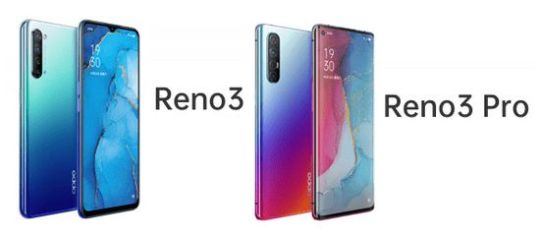
Both models work under running under Android 10 + ColorOS 7. OPPO Reno3 Pro 5G uses a 6.5-inch Full HD+ AMOLED screen with 2400 x 1080 resolution (402 ppi density) with support for 90 Hz refresh rate and 97% coverage of NTSC standard, four camera system (48MP Sony IMX586, f/1.7 + 8MP f/2.2, 116 ° + 13MP f/2.4 + 2MP f/2.4) and 32MP (f/2.4) selfie camera, RAM 8/12GB and 128/256 storage. Given its cost of up to $ 500, the model has excellent chances of success.
Conclusion
Innovative focus, including shark fin and SuperVOOC Fast Charge 2.0, high-level components and affordable prices provide good prospects for Oppo phones. Today many consumers make a choice in favor of this brand when buying a smartphone. In addition, the company can gain a foothold in the segment of inexpensive flagships with the help of its very promising Oppo Reno series. The video offers the announcement of the new Oppo F15 Pro. Read the full article
#AISelfieTune2.0#ColorOS7#CorePilottechnology#DCdimmingtechnology#OppoA5s#OppoA8#OppoA91#OppoF11#OppoF11Pro#OppoF15Pro#OppoFindX#OppoK3#OppoK5#Oppophones#OppoReno#OppoReno10xZoom#OppoReno3#OppoReno3Pro#OppoReno2#OppoReno2F#OppoReno2Z#sharkfinphones#SuperVOOCFastCharge2.0
0 notes
Text
Sony A80K OLED TV Review, Design, Price and Release Date
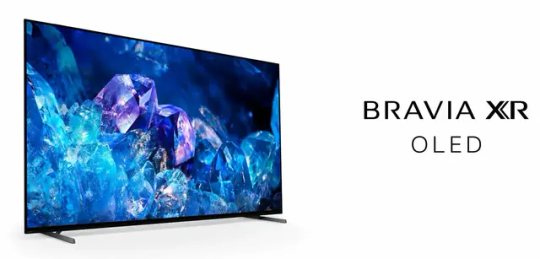
Sony A80K OLED TV Overview: The Sony A80K combines the remarkable contrast and rich color palette expected from OLEDs. In addition, it's enhanced with 4K 120Hz capabilities ideal for gaming and the unique Acoustic Surface Audio+ technology from Sony. This OLED TV delivers stellar performance without stretching your budget. Prices: €1,309 at OTTO DE (55-inch) €1,429 at Coolblue DE €1,999 at EURONICS DE (65-inch) Pros: Superior contrast with deep blacks and noteworthy brightness True-to-life colors straight out of the box in Cinema mode Comprehensive HDMI 2.1 features tailored for gamingCons: Slightly less brightness compared to leading OLED TVs Basic remote design missing backlight feature Absence of HDR10+ compatibility.
Sony A80K Review
The Sony Bravia XR A80K OLED is passionately engineered to redefine the boundaries of home entertainment. Remarkably, it excels in this pursuit, making it all the more surprising that its price tag isn't steeper. While the A80K isn't easy on the wallet, its value is undeniable. As one of Sony's premium OLED offerings, it's brimming with the brand's top-tier visual and auditory tech. Even though it might not outshine every competitor in all aspects, it undeniably ranks as one of the top TV purchases available. SONY BRAVIA XR A80K - SPECS - Price: $1,499.99 - Screen Size: 55-inch - Model Number: XR-55A80K - Resolution: 3,840 x 2,160 pixels - HDR Compatibility: HDR10, Dolby Vision, HLG - Refresh Rate: 120Hz - Connectivity: - HDMI: 2 ports of HDMI 2.1, 2 ports of HDMI 2.0 - USB: 2 ports - Audio Output: 50W - Smart TV Platform: Google TV - Dimensions (without stand): 48.38 inches (width) x 28.13 inches (height) x 2.13 inches (depth) - Weight (without stand): 39.5 lbs. This TV merges the best of Sony's technology, delivering exceptional picture quality, sound, and smart features.
Sony A80K Design Review
The A80K flaunts Sony's elegant One Slate design, seamlessly merging aesthetics with an all-glass front panel, roughly half an inch deep. This cohesive look is undeniably eye-catching. Incorporating functionality, an inset at the back facilitates hassle-free connections, complemented by a snap-on cover to manage and hide cables. The TV comes with a versatile three-way stand that can be adjusted for various setups – whether you want it flush with the stand or elevated to accommodate a soundbar. In my setup, I utilized the latter, gaining a good three inches of clearance. If you possess one of those bulkier soundbars, this stand offers the flexibility you need. For those who prefer wall installations, Sony offers an optional bracket. https://www.youtube.com/watch?v=q-Y-HDuAAxs Sony's accompanying remote is succinct in its design – a departure from the larger, glow-in-the-dark versions from their past models. While its straightforward button configuration is user-friendly, the absence of a backlit keypad can be a slight inconvenience in low light settings. However, Sony earns kudos for the remote's textured surface, minimizing the risk of it slipping through fingers or vanishing in the couch gap. Design Rating: 4.5/5.
Sony A80K Features Overview
Equipped with Google TV, the A80K OLED allows smooth app navigation, complemented by the convenience of Google Assistant for voice-activated searches. This is made possible through the microphone incorporated into the Sony remote. Popular streaming services such as Netflix, Disney+, Amazon Prime Video, HBO Max, and Apple TV are easily accessible, with dedicated buttons on the remote for quick access. In the realm of picture quality, the 2022 Sony OLED models are enhanced with the XR OLED Contrast Pro and Cognitive Processor XR technologies. These work in tandem to optimize brightness and deepen blacks dynamically, adapting to each scene. Furthermore, the broad color gamut panel, coupled with the XR Triluminos Pro and Cognitive Processor XR, ensures faithful color reproduction, covering the full DCI-P3 spectrum – the gold standard for digital cinema and Ultra HD Blu-ray content. Connectivity-wise, the A80K boasts four HDMI ports, of which two are HDMI 2.1 compliant. This means they support advanced features such as 4K at 120Hz, VRR, and ALLM. For US viewers, there's an added bonus: the A80K incorporates an ATSC 3.0 tuner. This advanced tuner facilitates access to free over-the-air digital TV broadcasts in the latest format, promising 4K visuals accompanied by Dolby Atmos audio. While ATSC 3.0 had a modest beginning, its adoption is on the rise, with predictions of it reaching three-quarters of the US market by the end of 2022. Feature Rating: 4.5/5.
Sony A80K Sound Quality Overview
The A80K OLED TVs are equipped with Sony's innovative Acoustic Surface Audio+ technology. By utilizing five actuators — three behind the screen and two on the sides — the screen itself is vibrated to produce encompassing sound, with two additional subwoofers augmenting bass levels. Additionally, features like Acoustic Audio Calibration adapt sound to the room's acoustics, Voice Zoom sharpens dialogue, and 3D surround upscaling enriches the auditory experience. While I often bypass a TV's native sound system in favor of external setups, I found the A80K's sound performance commendable. Dialogues were articulate and clear, even at higher volumes without any discernable distortion. The Dolby Atmos mode provided an immersive soundscape, with perceivable vertical and overhead sound dimensions. While an external Dolby Atmos soundbar might have fine-tuned the audio experience further, the A80K’s inherent sound system is impressive enough, especially for those not regularly indulging in action-packed cinema or those who prefer not to invest in an additional soundbar. Sound Quality Rating: 5/5.
Sony A80K Pricing and Availability Overview
Release Date: May 30, 2022 Pricing: - XR-55A80K: $2,000 (US) / £2,099 (UK) / AU$3,899 (Australia) - XR-65A80K: $2,300 (US) / £2,899 (UK) / AU$4,999 (Australia) - XR-77A80K: $3,300 (US) / £3,999 (UK) / AU$7,999 (Australia) Sony unveiled the A80K in the latter part of spring 2022. Positioned as the brand's mid-tier OLED model, the A80K's price point is notably more accessible compared to Sony's premium A95K QD-OLED lineup. In terms of competition, LG's C2 OLED stands out. The pricing dynamics between the Sony A80K and LG C2 vary by region. For instance, in the US, the 65-inch and 77-inch A80K models are priced slightly below their LG C2 counterparts, while the 55-inch variant leans towards a higher price compared to the LG C2 of the same size. Meanwhile, in the UK, Sony's A80K has a steeper price across all sizes when juxtaposed against the LG C2.
Sony A80K Picture Quality Overview
With its impressive 99.5% coverage of the DCI-P3 color space for 4K HDR, the A80K showcases a vibrant display. Its brightness capabilities are noteworthy for an OLED TV, boasting 785 nits in Vivid mode and a commendable 616 nits in Cinema mode. Though it doesn't match the brilliance of the Samsung QN95B mini-LED QLED or LG's flagship G2 OLED, its brightness suffices for most ambient settings. During my real-world testing with the Netflix documentary, "My Octopus Teacher," the display remained vivid, even with overhead lights. Despite lacking anti-glare features like Samsung's The Frame, reflections were minimal. The OLED panel ensures consistent visuals from varied angles. While the A80K misses the Filmmaker picture mode found in many premium TVs, its Cinema mode proves color accurate right out of the box. However, purists may need to adjust the default Motionflow settings. Key Specifications: - Screen Size: 55, 65, 75 inches - Resolution: 4K - Panel Type: OLED - HDR Support: Dolby Vision, HDR10, HLG - Audio: Dolby Atmos, Dolby Digital, DTS - Smart TV Platform: Google TV - HDMI Ports: 4 The A80K's 120Hz refresh rate delivers proficient motion handling, though some artifacts were observed, which could be mitigated through Motionflow settings. Its prowess in upscaling HD content to 4K was evident, possibly due to enhancements in Sony’s Cognitive Processor XR for 2022. In a dimly lit setting, 4K Blu-ray titles like "Dune" and "The Batman" were spectacular, exhibiting true blacks and intricate details in dark scenes. Bright HDR elements, juxtaposed against these dark backgrounds, offered a striking, almost 3D appearance. The capability to measure 0 nits on a full-black window pattern underpins its exceptional black rendition and robust contrast, especially under dim lighting. Picture Quality Rating: 4.5/5.
Sony Bravia XR A80K TV Ports Overview
The power cable for the A80K connects on the right side of its rear panel. Conveniently, all other ports are situated on the left, directly facing sideways for easy access. The lineup includes: - Two USB ports (one at 500mA and the other at 900mA). - S/PDIF optical audio output. - Composite video and S-Center speaker port. - Ethernet port. - RS-232C and IR input jacks. - Coaxial cable input. - Four HDMI ports. Of these HDMI ports, two are based on the latest HDMI 2.1 specification, boasting a hefty bandwidth of 48Gbps and modern features such as VRR and ALLM. One of these HDMI 2.1 ports is also eARC compatible. However, the other two HDMI ports stick to the older HDMI 2.0 standard. Although many TVs still feature exclusively HDMI 2.0 ports, it's a tad underwhelming to see this on the A80K. Nonetheless, this might not be a major concern for the average user.
Sony Bravia XR A80K TV Review: Technical Insights
While the real-world viewing experience is crucial, we ensure a holistic review by conducting a comprehensive suite of technical tests. Our evaluation setup involves using an X-Rite i1 Pro spectrophotometer, a SpectraCal VideoForge Pro pattern generator, and the Calman calibration software by Portrait Displays. For a deeper dive into our testing methodology, refer to our TV testing guide. In these technical evaluations, the A80K held its own, even against robust competitors like the Samsung S95B and the almost iconic LG C2. Test MetricsSony A80KLG C2Samsung S95BSDR Brightness (10%, in nits)232228329Delta-E (lower is better)3.16691.70093.0184Rec. 709 Gamut Coverage108.82.980%HDR Brightness (10%, in nits)6307941050UHDA-P3 Gamut Coverage99.33.16.76%Rec. 2020 Gamut Coverage74.58.84.97% For SDR content, the A80K's brightness of 232 nits was comparable to the LG C2's 228 nits, though it trailed behind Samsung's robust 329 nits. LG C2 took the crown in terms of color precision, showcasing the best Delta-E value. The A80K exhibited a minor color oversaturation, while the others were nearly perfect. When it comes to HDR, the narrative remains consistent. In their calibrated modes, Samsung dominated, but Sony's brightness lagged somewhat. Nevertheless, Sony's gamut coverage for both UHDA-P3 and Rec. 2020 surpassed LG C2 and was only marginally behind Samsung. Given that the A80K, especially the 55-inch variant, is priced a tad lower, its performance metrics are commendable. Moreover, certain inconsistencies in the S95B's display meant that, to the naked eye, the A80K presented a superior visual experience. Weighing in the cost against the features, the A80K emerges as a polished contender, offering an impressive viewing experience both objectively and subjectively.
Sony Bravia XR A80K TV Gaming Review:
When it comes to the recent lineup of Sony TVs, input lag is a bit of a chink in the armor. Using the Leo Bodnar 4K Lag Tester on the A80K, we recorded an input lag of 16.2ms. While this isn't a deal-breaker (with scores under 20ms being acceptable), it doesn't quite match the sub-10ms performance of competitors like LG and Samsung, which we earmark as the gold standard for gaming. Sony Bravia XR A80K TV showcasing Assassin’s Creed Valhalla That being said, the A80K isn't lacking in gaming-centric features. A significant highlight is its HDMI 2.1 ports, enabling 4K gaming at a fluid 120Hz. This ensures a silky-smooth experience, even in high-intensity gaming sequences. This was particularly evident in Assassin’s Creed Valhalla — the game’s snowy landscapes shimmered with realistic brilliance, and the essential coastal raids in the gameplay were as smooth and exhilarating as one would expect. Furthermore, when paired with the PS5, the A80K steps up its game. Features like Auto HDR Tone Mapping tailor the PS5’s settings to maximize the TV's potential. The Auto Genre Picture Mode, reminiscent of ALLM, ensures optimal picture settings, enhancing the visual experience regardless of the content being played.
Sony A80K Value Assessment
Positioned between Sony's high-end A95K QD-OLED and A90K and the more accessible European A75K in their 2022 OLED lineup, the A80K is crafted for those balancing between premium performance and cost-effectiveness. For U.S. consumers, the 65-inch A80K, priced lower than its LG C2 counterpart while offering comparable visual prowess, stands as an attractive proposition. In the UK, while it may lean on the pricier side, the A80K compensates with superior audio capabilities than the LG C2. An alternative avenue for better value might be TVs with QLED technology. However, venturing into the economical side of QLED often demands compromises in performance. Summing up, the 65-inch A80K is a prime choice for those set on acquiring a 4K OLED TV. For those chasing maximum screen size within a budget, without sacrificing quality, QLED emerges as a more fitting option. Should I buy the Sony A80K? Whether or not you should buy the Sony A80K largely depends on your specific needs, preferences, and budget. Here are some factors to consider: Pros of the Sony A80K: - Outstanding Picture Quality: The A80K boasts excellent color accuracy, deep blacks, and detailed shadows, characteristic of OLED panels. - Sound: The Acoustic Surface Audio+ technology delivers immersive sound quality without needing external speakers. - Gaming: While it might not be the absolute best in terms of input lag, the inclusion of HDMI 2.1 ports allows for high-refresh-rate gaming, making it compatible with next-gen consoles. - Design: The slim and sleek design, coupled with the One Slate concept, makes it an aesthetically pleasing addition to any room. - Smart Features: Powered by Google TV, it offers a wide array of apps and streaming services. Cons of the Sony A80K: - Input Lag: Some competitors, especially those designed with gaming in mind, offer lower input lag. - HDMI 2.1 Ports: It has fewer HDMI 2.1 ports compared to some other modern TVs, which might be a consideration for those with multiple high-end gaming consoles or other devices. - Price: OLED TVs generally cost more than their LED or QLED counterparts, and while the A80K offers value for its price, there are cheaper options available, especially if you are willing to compromise on some features. Things to consider: - Viewing Environment: OLEDs are known for deep blacks and great contrast ratios, making them ideal for dimly lit or controlled lighting environments. If your room is very bright, you might want to consider other options or ensure you can control the lighting. - Burn-in Concerns: Like all OLED TVs, there's a risk (albeit minimal with proper use) of burn-in over time. This happens when static images are displayed for prolonged periods repeatedly. Verdict: If you're in the market for a high-quality OLED TV with excellent picture and sound, and you value Sony's design and user interface, the A80K is a strong choice. However, if gaming performance is your top priority or you're budget-conscious, you might want to compare it with other options like the LG C2 or certain QLED models. Always consider what features are most crucial for you and how they align with your budget. Conclusion While the Sony Bravia XR A80K is an impressive piece of tech, it isn't without its shortcomings. TVs like the Samsung S95B may offer slightly enhanced brightness and color vibrancy. Furthermore, both the Samsung S95B and the LG C2 boast additional HDMI 2.1 ports and superior gaming features, which could be pivotal for gaming enthusiasts. The A80K isn't even Sony's crown jewel – that honor goes to the pricier Sony A95K OLED. Also, it bears striking resemblance in features and performance to its predecessor, the Sony Bravia XR A80J. Yet, when contemplating a new TV purchase, the Sony Bravia XR A80K emerges as a comprehensive package that promises a delightful viewing experience each time it's powered on. Read the full article
0 notes